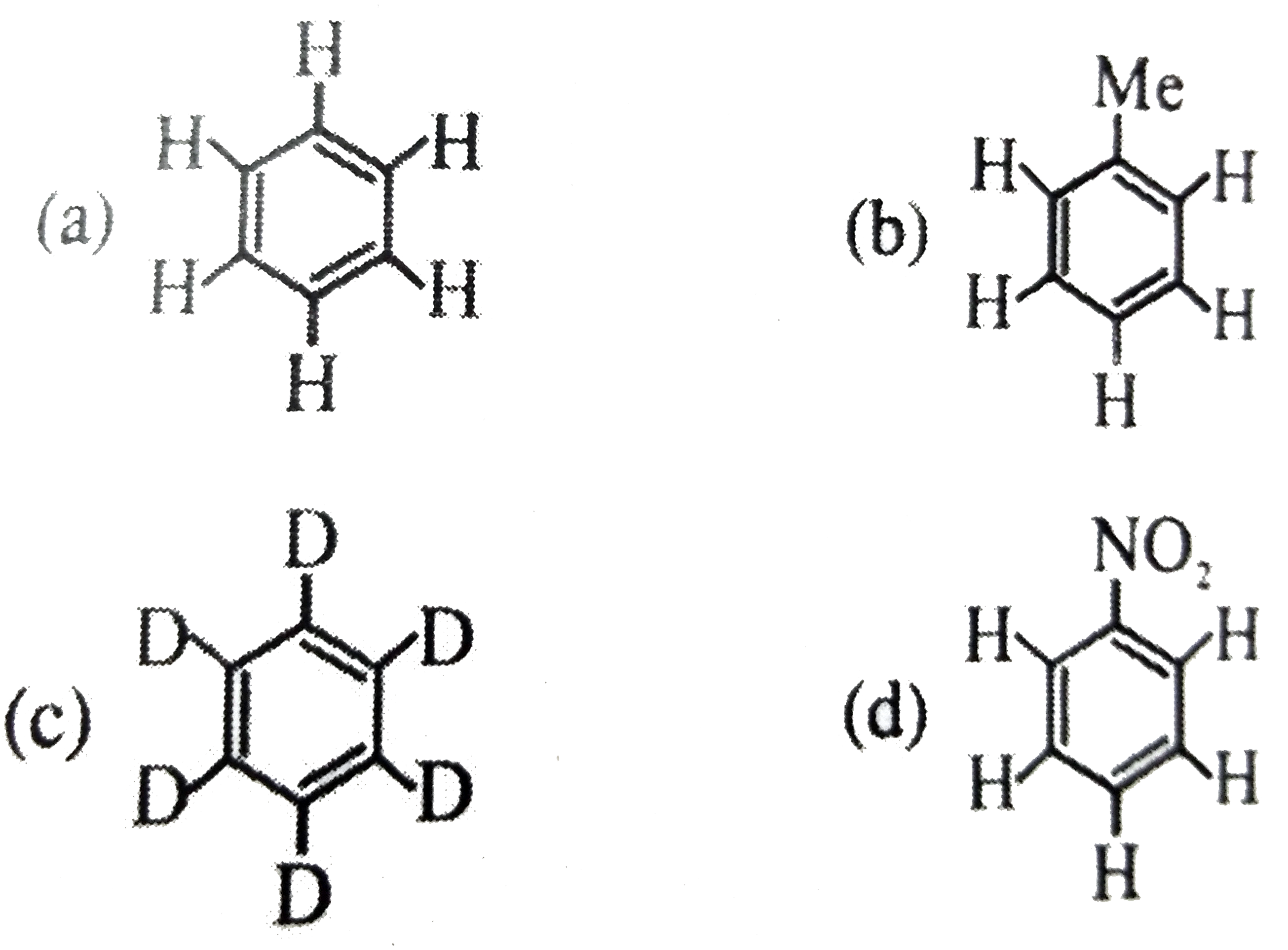Arrange the following according to the rate of nitration: para xylene, bromo benzene, mesitylene, benzene.
To determine the rate of nitration of the compounds para xylene, bromo benzene, mesitylene, and benzene, we need to analyze the electron-donating or withdrawing effects of the substituents on the benzene ring. The nitration reaction involves the electrophilic attack of the nitronium ion (NO2+), which requires a higher electron density on the aromatic ring for a faster reaction.
1. Identify the Compounds and Their Structures:
- Para xylene (C8H10): Contains two methyl (CH3) groups at the para positions on the benzene ring.
- Bromo benzene (C6H5Br): Contains a bromine (Br) atom attached to the benzene ring.
- Mesitylene (C9H12): Contains three methyl (CH3) groups attached to the benzene ring.
- Benzene (C6H6): The simplest aromatic compound with no substituents.
2. Determine the Effects of Substituents:
- Methyl Group (CH3): Exhibits a +I (inductive) effect, which increases the electron density on the benzene ring, making it more reactive towards electrophiles like NO2+.
- Bromine (Br): Exhibits a -I (inductive) effect, which decreases the electron density on the benzene ring, making it less reactive towards electrophiles.
3. Analyze Electron Density:
- Mesitylene: Has three methyl groups, providing the highest electron density due to their +I effect.
- Para xylene: Has two methyl groups, resulting in a lower electron density compared to mesitylene but higher than benzene and bromo benzene.
- Benzene: Has no substituents, so it has a moderate electron density.
- Bromo benzene: The presence of bromine decreases the electron density due to its -I effect, making it the least reactive towards nitration.
4. Rank the Compounds Based on Electron Density:
- 1st: Mesitylene (highest electron density)
- 2nd: Para xylene
- 3rd: Benzene
- 4th: Bromo benzene (lowest electron density)
Final Arrangement According to the Rate of Nitration:
1. Mesitylene
2. Para xylene
3. Benzene
4. Bromo benzene
- Para xylene (C8H10): Contains two methyl (CH3) groups at the para positions on the benzene ring.
- Bromo benzene (C6H5Br): Contains a bromine (Br) atom attached to the benzene ring.
- Mesitylene (C9H12): Contains three methyl (CH3) groups attached to the benzene ring.
- Benzene (C6H6): The simplest aromatic compound with no substituents.
- Methyl Group (CH3): Exhibits a +I (inductive) effect, which increases the electron density on the benzene ring, making it more reactive towards electrophiles like NO2+.
- Bromine (Br): Exhibits a -I (inductive) effect, which decreases the electron density on the benzene ring, making it less reactive towards electrophiles.
- Mesitylene: Has three methyl groups, providing the highest electron density due to their +I effect.
- Para xylene: Has two methyl groups, resulting in a lower electron density compared to mesitylene but higher than benzene and bromo benzene.
- Benzene: Has no substituents, so it has a moderate electron density.
- Bromo benzene: The presence of bromine decreases the electron density due to its -I effect, making it the least reactive towards nitration.
- 1st: Mesitylene (highest electron density)
- 2nd: Para xylene
- 3rd: Benzene
- 4th: Bromo benzene (lowest electron density)
1. Mesitylene
2. Para xylene
3. Benzene
4. Bromo benzene
Topper's Solved these Questions
Similar Questions
Knowledge Check
Arrange the following in incresing order of rate of Nitration :
(a) Ab<c<a<d<eBd<e<a=c<bCd<a=c<e<bDa<c<b<e<d
Ab<c<a<d<eBd<e<a=c<bCd<a=c<e<bDa<c<b<e<dArrange the following in decreasing order of rate of nitration :-
 Ab>a=c>dBd>a=c>bCb>a>c>dDa>c>d>b
Ab>a=c>dBd>a=c>bCb>a>c>dDa>c>d>bNitration and chlorination of benzene are
Anucleophilic and electrophilic substitution respectivelyBelectrophilic and nucleophilic substitution respectivelyCelectrophilic substitution in both the reactionDnucleophilic substitution in both the reaction.
Arrange the following compounds in order of increasing dipole moment:
(i) toluene (ii) m-dichloro benzene
(iii) o-dichloro benzene (iv) p-dichloro benzene
View SolutionNitration of benzene is:
View SolutionThe rate determining step for the preparation of nitrobenzene from benzen is
View SolutionThe rate determining step for the preparation of nitrobenzene from benzen is
View SolutionArrange the following compound in order of increasing dipole moment :
(I) 1, 3, 5-Trichloro benzene
(II) 1, 2, 4-Trichloro benzene
(III) 1, 2, 3, 4-Tetrachloro benzene
(IV) P-dichloro benzene
View Solution
